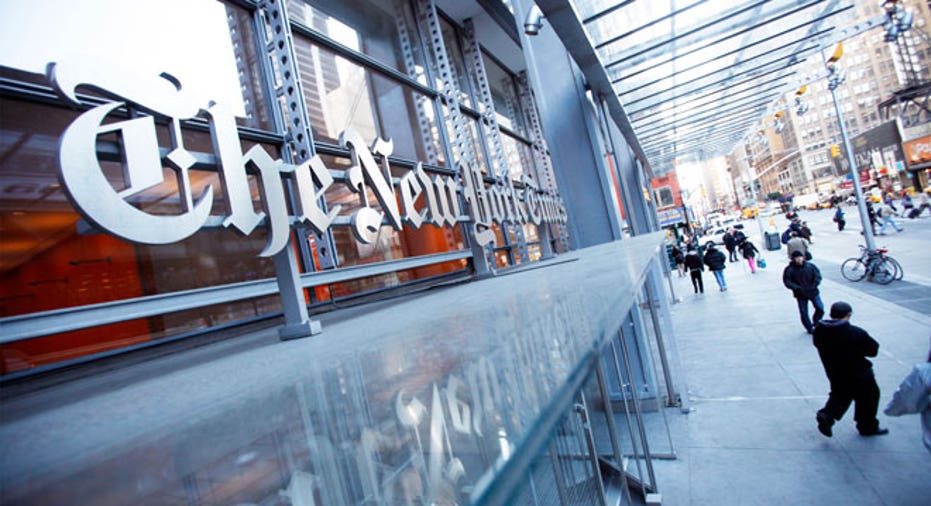NY Times Pay Wall Slowly Converting Skeptics

In the face of widespread skepticism, the pay wall at The New York Times appears to be making surprising inroads. Indeed, the plan has the potential to give the company an influx of $100 million in annual revenues and set a roadmap for the rest of the industry.
The New York Times Co. (NYSE:NYT), in a show of confidence, said on Tuesday it is halving the number of free articles users can access on the website of the Times. It also revealed 454,000 paid digital subscribers to the Times and International Herald Tribune, marking an impressive 16.4% rise since the end of 2011.
“In my wildest dreams when they rolled this out a year ago, I didn’t think they’d be at over 450,000 subscribers a year later,” said Douglas Arthur, an analyst who covers the company at Evercore Partners (NYSE:EVR). “The execution, the threading the needle between free and restricted access and harvesting of its huge unique visitor number has been pretty flawless.”
Rolled out in March 2011, the Times pay wall aims to generate revenue by converting at least some of the website’s millions of free visitors into paying customers. For an average of $250 a year, paid digital subscribers receive unlimited access to the site, compared with $629 a year for a seven-day print subscription.
Execution Risk Looms
If the Times is able to parlay its early success into meaningful revenue over the next year, its pay wall could serve as a model for many other companies in the hurting newspaper industry. But that remains a big "if," especially for a company that has suffered a number of recent stumbles and remains CEO-less.
“Their execution effort, if you go back in history, hasn’t been very successful. Justifiably, a lot of people still aren’t giving them a lot of credit and want to wait to see if the momentum continues,” said Kannan Venkateshwar, who covers the stock at Barclays (NYSE:BCS).
That apprehension is underscored by Morningstar analyst Joscelyn MacKay, who believes the Times is at a competitive disadvantage with rival The Wall Street Journal, which is owned by FOX Business parent News Corp. (NASDAQ:NWSA).
“As great of a newspaper as The New York Times is, I do view the Times as a ‘nice to have’ and The Wall Street Journal as a ‘need to have,” said MacKay. “We're still very skeptical over here that this is going to be a meaningful revenue driver."
In 2005 the Times rolled out a similar effort, TimesSelect, which required users to pay to access premium content such as Op-Ed and columns. Ultimately, that plan flopped and the paper returned to an all-free model in 2007.
The execution risk at the Times is heightened by the lack of a full-time CEO following the departure late last year of Janet Robinson.
While the company searches for a replacement, Chairman and Publisher Arthur Sulzberger, Jr., is temporarily serving as CEO. Sulzberger has said the Times is searching for someone with a strong brand-building and digital resume.
“I always worry about execution at the Times, [especially] with no CEO in place,” said Arthur.
Eye on Advertisers
Another concern is that the pay wall could cause a revolt among advertisers who are upset about the lower number of potential eye balls on the site.
The Times seemed to allude to that worry, noting in its statement on Tuesday that its digital subscription plan will continue to provide access to a “generous amount of free content” on the website and across other platforms.
Despite the execution concerns and early skepticism, the pay wall does seem to be creating some early believers.
“No matter what benchmark you use, they’ve been extremely successful in just one year,” said Venkateshwar, who pointed to the Journal’s 1.3 million paid digital subscribers and significant head start.
He said the fact that the Times is halving its free monthly articles “proves they are able to retain traffic in spite of the pay wall.”
$100M Revenue Boost?
Both Venkateshwar and Arthur separately said they believe the pay wall is on track to generate about $100 million in annual revenue for the company. Venkateshwar, who has an equal weighting and an $8 price target on the stock, said these additional revenues could boost the equity price by 10% to 20%.
While the pay wall is likely to eat into print subscription revenue by luring subscribers to the digital side, Venkateshwar predicted it would also reduce the churn rate and boost overall digital revenue.
Other papers seem to be catching on, with Gannet (NYSE:GCI), the Chicago Sun-Times and the Milwaukee Journal Sentinel introducing pay walls of their own in recent months.
“Everyone said it’ll never work. Now they’re seeing the Times rocket ship and you’re seeing pay walls left, right and center,” said Arthur.